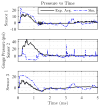Elucidating the role of compression waves and impact duration for generating mild traumatic brain injury in rats
- PMID: 27880054
- PMCID: PMC5247354
- DOI: 10.1080/02699052.2016.1218547
Elucidating the role of compression waves and impact duration for generating mild traumatic brain injury in rats
Abstract
Background: In total, 3.8 million concussions occur each year in the US leading to acute functional deficits, but the underlying histopathologic changes that occur are relatively unknown. In order to improve understanding of acute injury mechanisms, appropriately designed pre-clinical models must be utilized.
Methods: The clinical relevance of compression wave injury models revolves around the ability to produce consistent histopathologic deficits. Mild traumatic brain injuries activate similar neuroinflammatory cascades, cell death markers and increases in amyloid precursor protein in both humans and rodents. Humans, however, infrequently succumb to mild traumatic brain injuries and, therefore, the intensity and magnitude of impacts must be inferred. Understanding compression wave properties and mechanical loading could help link the histopathologic deficits seen in rodents to what might be happening in human brains following concussions.
Results: While the concept of linking duration and intensity of impact to subsequent histopathologic deficits makes sense, numerical modelling of compression waves has not been performed in this context. In this interdisciplinary work, numerical simulations were performed to study the creation of compression waves in an experimental model.
Conclusion: This work was conducted in conjunction with a repetitive compression wave injury paradigm in rats in order to better understand how the wave generation correlates with histopathologic deficits.
Keywords: Finite volume modelling; apoptosis; compression wave; pre-clinical model; traumatic brain injury.
Conflict of interest statement
Declarations of Interest: None
Figures







Similar articles
-
Weight Drop Models in Traumatic Brain Injury.Methods Mol Biol. 2016;1462:193-209. doi: 10.1007/978-1-4939-3816-2_12. Methods Mol Biol. 2016. PMID: 27604720
-
The accumulation of brain injury leads to severe neuropathological and neurobehavioral changes after repetitive mild traumatic brain injury.Brain Res. 2017 Feb 15;1657:1-8. doi: 10.1016/j.brainres.2016.11.028. Epub 2016 Dec 5. Brain Res. 2017. PMID: 27923640
-
Concussion in professional football: animal model of brain injury--part 15.Neurosurgery. 2009 Jun;64(6):1162-73; discussion 1173. doi: 10.1227/01.NEU.0000345863.99099.C7. Neurosurgery. 2009. PMID: 19487897
-
Mechanisms underlying vulnerabilities after repeat mild traumatic brain injuries.Exp Neurol. 2019 Jul;317:206-213. doi: 10.1016/j.expneurol.2019.01.012. Epub 2019 Mar 8. Exp Neurol. 2019. PMID: 30853388 Review.
-
The pathophysiology of repetitive concussive traumatic brain injury in experimental models; new developments and open questions.Mol Cell Neurosci. 2015 May;66(Pt B):91-8. doi: 10.1016/j.mcn.2015.02.005. Epub 2015 Feb 13. Mol Cell Neurosci. 2015. PMID: 25684677 Free PMC article. Review.
Cited by
-
Low-intensity Blast Wave Model for Preclinical Assessment of Closed-head Mild Traumatic Brain Injury in Rodents.J Vis Exp. 2020 Nov 6;(165):10.3791/61244. doi: 10.3791/61244. J Vis Exp. 2020. PMID: 33226021 Free PMC article.
-
Factors Contributing to Life-Change Adaptation in Family Caregivers of Community-Dwelling Individuals with Acquired Brain Injury.Healthcare (Basel). 2023 Sep 22;11(19):2606. doi: 10.3390/healthcare11192606. Healthcare (Basel). 2023. PMID: 37830643 Free PMC article.
-
The impact of adolescent drinking on traumatic brain injury-induced cognitive deficits and alcohol preference in adult C57BL/6J mice.Alcohol Clin Exp Res (Hoboken). 2025 May;49(5):1013-1027. doi: 10.1111/acer.70027. Epub 2025 Mar 23. Alcohol Clin Exp Res (Hoboken). 2025. PMID: 40123100
-
Examining the Correlation between Acute Behavioral Manifestations of Concussion and the Underlying Pathophysiology of Chronic Traumatic Encephalopathy: A Pilot Study.J Neurol Psychol. 2018 May;6(1):10.13188/2332-3469.1000037. doi: 10.13188/2332-3469.1000037. Epub 2018 May 11. J Neurol Psychol. 2018. PMID: 30079371 Free PMC article.
References
-
- McClure DJ, Zuckerman SL, Kutscher SJ, Gregory AJ, Solomon GS. Baseline neurocognitive testing in sports-related concussions: the importance of a prior night's sleep. Am J Sports Med. 2014;42(2):472–8. - PubMed
-
- McCrea M, Guskiewicz KM, Marshall SW, Barr W, Randolph C, Cantu RC, Onate JA, Yang J, Kelly JP. Acute effects and recovery time following concussion in collegiate football players: the NCAA Concussion Study. JAMA. 2003;290(19):2556–63. - PubMed
-
- Bailes JE, Turner RC, Lucke-Wold BP, Patel V, Lee JM. Chronic Traumatic Encephalopathy: Is It Real? The Relationship Between Neurotrauma and Neurodegeneration. Neurosurgery. 2015;62(Suppl 1):15–24. - PubMed
Publication types
MeSH terms
Grants and funding
LinkOut - more resources
Full Text Sources
Other Literature Sources
Medical
